
Go World Travel is reader-supported and may earn a commission from purchases made through links in this piece.
Poland offers many impressive sights. From palaces to museums, concert venues to parks and much more can be found throughout the nation. Many of the sights are concentrated in such major cities as Warsaw, Gdansk, Wroclaw, and Krakow.
While Warsaw is the capital of Poland, many consider its soul to be Krakow. From St. Mary’s Basilica and the old Cloth Hall market in Old Town to the ruin pubs and Synagogues in Kazimierz, there is much to experience in Krakow. My 12-year-old son, Alex, and I learned this the fun way during a recent visit.
Exploring Wawel Hill
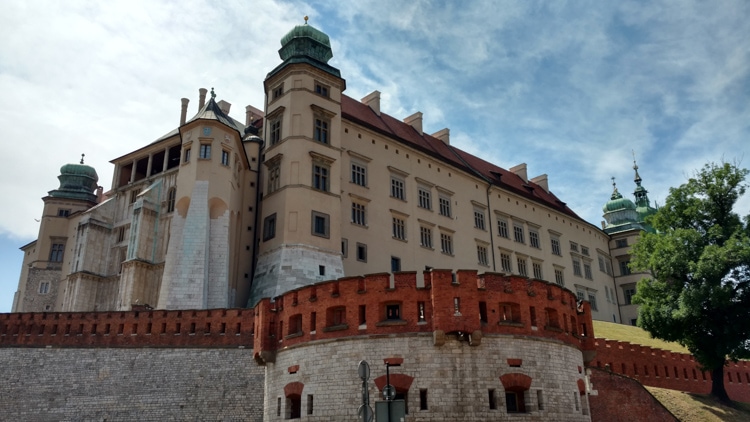
The crown jewel of Krakow is The Wawel. This is a fortress on a hill overlooking Old Town, complete with a castle, a cathedral and museums, all fortified by a protective wall. Wawel Hill is revered as the most important cultural and historical site in all of Poland.
Best Tips & Tools to Plan Your Trip
The Royal Castle is among the most majestic royal residences of Central Europe. Having been rebuilt several times, the current rendition of the four-winged palace features an array of styles from past editions, from Renaissance to Medieval to Baroque.
Alex and I found the Royal Apartments to be less impressive than the ones in Warsaw’s castle. However, there’s no arguing that the exterior of Wawel Castle is far more eye-catching, from its domes to its vast courtyard.
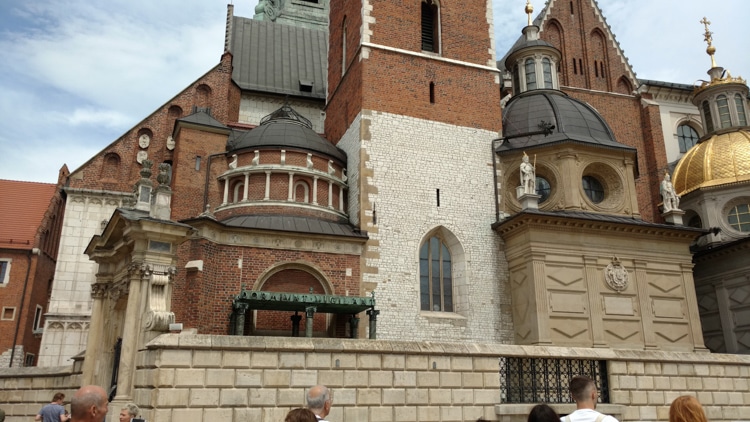
In the courtyard of the castle we noticed a group of travel-worn hippies collected along one of the walls in the northeast corner. They took turns standing against the wall in one spot, some of them hugging it, others holding their hands to it, still others seeming to meditate with eyes closed.
Alex and I approached the wall, a dull yellow brown, and found it to be black in one large spot from all the pilgrims who’ve come to touch the wall.
“What’s all this?” I asked.
An American man with long dreadlocks answered. “It’s, like, a Sankara Stone, man.”
“Sankara Stone?”
“You know, from Indian Jones? Those holy stones from India with magical powers. There’s one in the wall. You can feel its power.”
The Mystical Wawel Stone
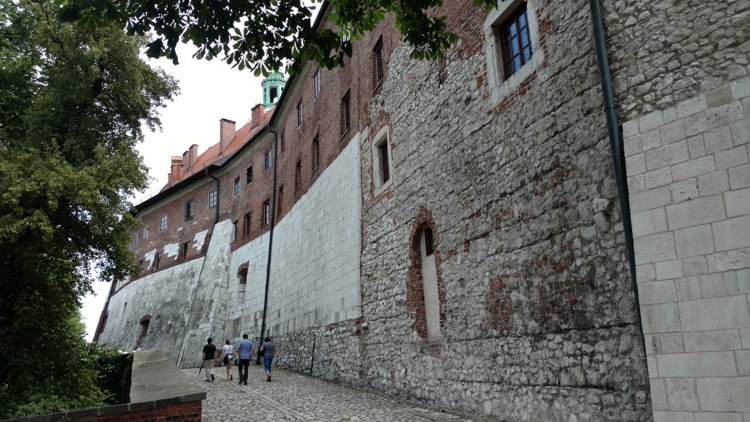
It turns out, this group did not represent an isolated incident. Thousands of people flock to the wall, believing it to have mystical properties. Some believe a Wawel Chakra, or Wawel Stone, is built into the wall, hidden away. This would be one of the five sacred stones fictionalized in the 1884 film, Indiana Jones and the Temple of Doom.
Others believe that this spot is one of the Earth’s natural ‘force centers’ not unlike the chakras of the human body. That puts this location on Wawel Hill, in the courtyard of Wawel Castle, on the list with corresponding locations in Rome, Delhi and Jerusalem.
The local tourism authorities and employees of the Wawel complex do not acknowledge the existence of a sacred stone or force center in the Wawel. In fact, they seem to be a little creeped out by it. At one point during our stroll through the courtyard, we saw a museum worker encouraging the pilgrims to leave.
When we casually asked about the stone later, wondering whether it was really in the wall, the employee acted like he didn’t know what we were talking about.
But there are other religious experiences on the hill that go along with the culture of the area.
More Sacred Sites on Wawel Hill
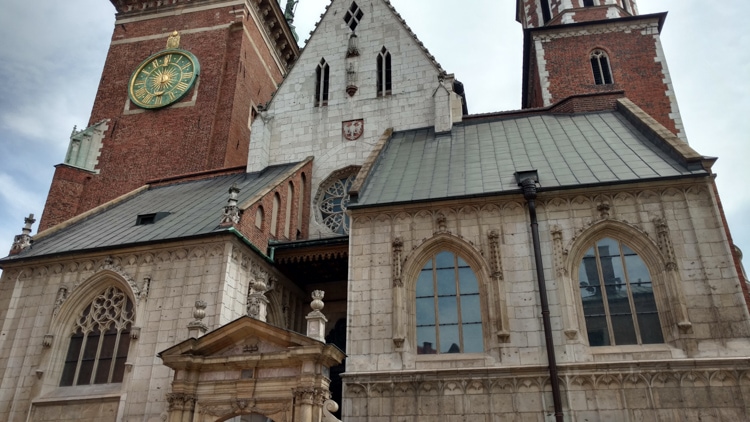
Wawel’s Cathedral of Saints Stanislaw and Waclaw is considered the spiritual center of Poland. Alex and I basked in the elaborately decorated interior, climbed the tower to see the Zygmunt Bell (the largest bell in Poland) and visited the tombs of Polish kings and royalty.
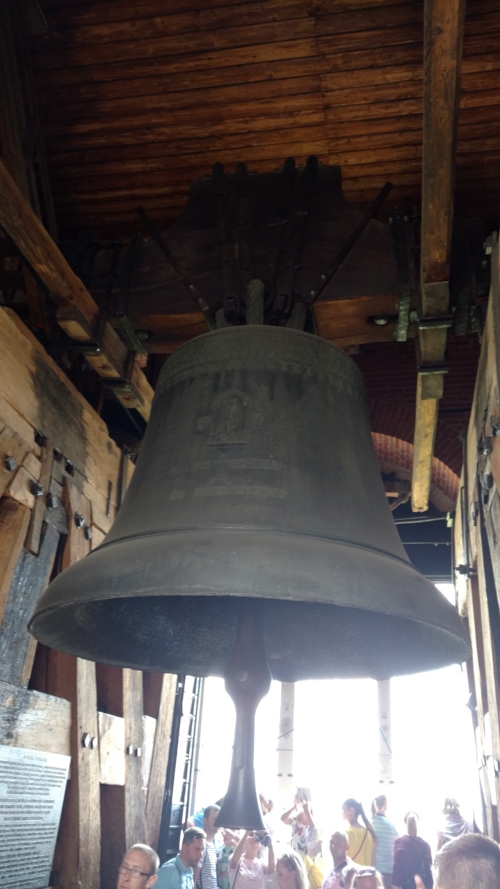
Also, on Wawel Hill are several museums. This includes a “Lost Wawel” exhibition that digs beneath the ground to reveal buildings and artifacts from centuries past.
Our exploration of Wawel Hill took up the better part of a day. We entered through the main walkway on the west side, which features an impressive monument to Tadeusz Kosciuszko, a hero of both Polish and American independence.
But we exited Wawel Hill by descending a towered staircase into the “Dragon’s Den.” After walking through the dark and dank caves, we came to the fire-breathing dragon. Alex and I watched as the bronze statue breathed fire.
“That reminds me,” Alex said. “Can we try one of those grilled Polish hot dogs?”
We’d seen vendors grilling the Polish sausages and then dipping them in batter and deep frying them. Sort of a Polish corn dog without a stick.
“That sounds like a good idea,” I said, and we headed toward one of the many squares in Kazimierz for dinner.
Staying in Krakow
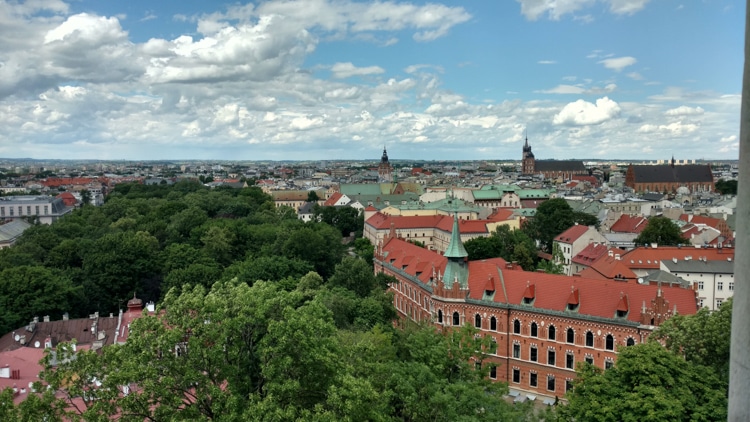
For long stays of more than a few days, we’ve had great luck renting well-reviewed apartments using Airbnb. For short stays, TripAdvisor and Booking.com offer spectacular deals on hotels.
Whichever route or combination you choose, be sure to consider the reviews along with location and price. Paying a little more to be in the center of the places you want to visit ends up saving time and money.
Best Tips & Tools to Plan Your Trip
In Krakow, we stayed in Agnieszka’s Kazimierz apartment, central and cozy. Two beds, a living room, eat-in kitchen and a memory wall where Alex and I left our impressions of the city in marker. In the heart of the Kazimierz neighborhood, it was a 10-minute walk from Wawel and Old Town.
This also gave us the opportunity to mingle with locals in the nearby cafes, restaurants and pubs. Also, in the public squares that always seem to be alive with activity.
Read More:
- Krakow Past and Present: A Visit to Krakow, Poland
- Krakow from Above: Tower Views of the Medieval City
- A Day in Krakow’s Old Town Square
- Exploring Jewish Krakow: Tracing the Rich History and Culture of Poland’s Jewish Community
Author Bio: Eric D. Goodman enjoys travel as much as he does writing. His poetry collection, Faraway Tables, is being published spring 2024. He’s author of Wrecks and Ruins, a novel set partially in Lithuania, The Color of Jadeite, a thriller set in China, Womb: a novel in utero, Tracks: A Novel in Stories, and Flightless Goose (2008).
His travel stories and short fiction have been published far and wide. Eric lives with his wife and children in Maryland, where he curates the popular Lit & Art Reading Series and is prose and poetry editor for BrickHouse Books. Learn more at www.EricDGoodman.com or connect at www.Facebook.com/EricDGoodman.
- Sailing the Amalfi Coast: Stunning Sights You’ll See With Star Clippers - November 9, 2024
- Krakow’s Wawel Hill: Dragons and Sacred Stones - March 13, 2024
- View the Turquoise Lakes of Plitvice National Park: Croatia’s Best-Kept Treasure - April 16, 2023

